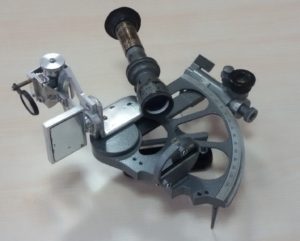Electronic sextant
 The essence and content of the project, the available groundwork. The analysis of the technical means installed on the vessels providing the possibility of obtaining the observable coordinates of the ship’s position allows us to conclude that the only backup (independent of the presence of a radio signal and power supply) is the astronomical way of determining the observable coordinates of the ship’s position when navigating on the high seas.
The essence and content of the project, the available groundwork. The analysis of the technical means installed on the vessels providing the possibility of obtaining the observable coordinates of the ship’s position allows us to conclude that the only backup (independent of the presence of a radio signal and power supply) is the astronomical way of determining the observable coordinates of the ship’s position when navigating on the high seas.
The improvement of the procedure of obtaining the astronomical observable position of the vessel is associated with the improvement of the instrument intended for measuring the observable navigation parameter-the height of the luminary-the navigation sextant. Any action to improve the design of sextant stopped in the 70-80s of the last century, and this device does not meet the state of the art and scientific achievements.
In two universities, independently of each other, research was carried out, which allowed to formulate, and prove in the experiment, directions for improving sextant:
1. Creation of a new optic-mechanical system of sextant, which expands the range of measured navigation parameters: not only the height of the luminary, but also the difference in heights and the difference in azimuths of the two luminaries. There is a significant reserve: a patent of the Russian Federation for the optical-mechanical system of sextant is obtained with the possibility of measuring three navigation parameters; two prototypes of improved sextants were made.
2. To develop an additional block to the standard sextant, which provides automatic transmission of the sextant readout via the radio channel to the computer (or an autonomous calculation unit – the calculator), where the remaining calculations are performed to obtain the observable coordinates of the ship’s position, taking into account all possible navigation parameters.
 Dedicated directions of improvement are not excessively complicated in the scientific and engineering sense, therefore, in each of the directions it is advisable to develop 3-4 research, engineering, commercial and entrepreneurial projects primary and secondary school students. An important component of these projects is their emotional and motivational component, since astronomical research and observations are always tempting for young people, fanned by romance, which creates the necessary emotional background for their attraction to the marine professions.
Dedicated directions of improvement are not excessively complicated in the scientific and engineering sense, therefore, in each of the directions it is advisable to develop 3-4 research, engineering, commercial and entrepreneurial projects primary and secondary school students. An important component of these projects is their emotional and motivational component, since astronomical research and observations are always tempting for young people, fanned by romance, which creates the necessary emotional background for their attraction to the marine professions.
Project results:
1. Development of pedagogical technologies to attract talented young people for engineering professions and engineering creativity to the maritime industry through a new direction – project activity.
2. Creation of a new competitive navigation device, which will be in demand in the maritime industry.
Admiral S.O. Makarov State University of the Maritime and Inland Shipping
Siberian State University of Water Transport
Please contact: koserbik@mail.ru, +7(904)3346872

 Русский
Русский